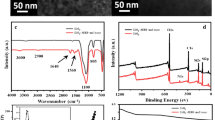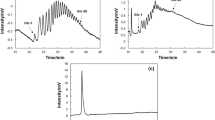Abstract
Obtaining well-defined Chitooligosaccharides (COS) structures is very important as their physicochemical and biological properties depends strongly on their degree of polymerization (DP) and degree of N-acetylation (DA). Hydrophilic Interaction Liquid Chromatography (HILIC), that is commonly used for COS analyses, suffers from several drawbacks, related to their complex structure, leading to broadening/splitting of the chromatogram signals. We investigated, herein, on the role of the equilibration step of an amino-based HILIC column on the separation of COS DP ≤ 5. We demonstrated that COS could be separated according to their DP after equilibrating the column by a NaHCO3 buffer solution (100 mM, pH = 10) and mild elution chromatographic parameters (neutral mobile phase, r.t.); or according to their DA after equilibrating the column by an NH4Ac buffer solution (50 mM, pH = 4.5). Also, the nature of the counterion of the column stationary phase was found to affect both retention times and signal profiles of analyzed COS.








Similar content being viewed by others
Availability of Data and Materials
Yes (see supporting data file).
Code Availability
Not applicable.
References
Liaqat F, Eltem R (2018) Chitooligosaccharides and their biological activities: a comprehensive review. Carbohyd Polym 184:243–259
Xia W, Liu P, Zhang J, Chen J (2011) Biological activities of chitosan and chitooligosaccharides. Food Hydrocoll 25:170–179
Phil L, Naveed M, Mohammad IS, Bo L, Bin D (2018) Chitooligosaccharide: an evaluation of physicochemical and biological properties with the proposition for determination of thermal degradation products. Biomed Pharmacother 102:438–451
Huang X, Jiao Y, Zhou C (2021) Impacts of chitosan oligosaccharide (COS) on angiogenic activities. Microvasc Res 134:104114
Cheung RC, Ng TB, Wong JH, Chan WY (2015) Chitosan: an update on potential biomedical and pharmaceutical applications. Mar Drugs. https://doi.org/10.3390/md13085156
Zargar V, Asghari M, Dashti A (2015) A review on chitin and chitosan polymers: structure, chemistry, solubility, derivatives, and applications. Chem Bio Eng Rev 2:204–226
Behera HT, Mojumdar A, Das SR, Jema S, Ray L (2020) Production of N-acetyl chitooligosaccharide by novel Streptomyces chilikensis strain RC1830 and its evaluation for anti-radical, anti-inflammatory, anti-proliferative and cell migration potential. Bioresour Technol Rep 11:100428
Hui A, Yan R, Wang W, Wang Q, Zhou Y, Wang A (2020) Incorporation of quaternary ammonium chitooligosaccharides on ZnO/palygorskite nanocomposites for enhancing antibacterial activities. Carbohydr Polym 247:116685
Kidibule PE, Santos-Moriano P, Plou FJ, Fernández-Lobato M (2020) Endo-chitinase Chit33 specificity on different chitinolytic materials allows the production of unexplored chitooligosaccharides with antioxidant activity. Biotechnol Rep (Amst) 27:e00500–e00500
Jafari H, Bernaerts KV, Dodi G, Shavandi A (2020) Chitooligosaccharides for wound healing biomaterials engineering. Mater Sci Eng C 117:111266
Maillet F, Poinsot V, André O, Puech-Pagès V, Haouy A, Gueunier M, Cromer L, Giraudet D, Formey D, Niebel A, Martinez EA, Driguez H, Bécard G, Dénarié J (2011) Fungal lipochitooligosaccharide symbiotic signals in arbuscular mycorrhiza. Nature 469:58–63
Halila S, Samain E, Vorgias CE, Armand S (2013) A straightforward access to TMG-chitooligomycins and their evaluation as β-N-acetylhexosaminidase inhibitors. Carbohyd Res 368:52–56
Tømmeraas K, Vårum KM, Christensen BE, Smidsrød O (2001) Preparation and characterisation of oligosaccharides produced by nitrous acid depolymerisation of chitosans. Carbohyd Res 333:137–144
Trombotto S, Ladavière C, Delolme F, Domard A (2008) Chemical preparation and structural characterization of a homogeneous series of chitin/chitosan oligomers. Biomacromol 9:1731–1738
Mao S, Shuai X, Unger F, Simon M, Bi D, Kissel T (2004) The depolymerization of chitosan: effects on physicochemical and biological properties. Int J Pharm 281:45–54
Xia Z, Wu S, Chen J (2013) Preparation of water soluble chitosan by hydrolysis using hydrogen peroxide. Int J Biol Macromol 59:242–245
Olicón-Hernández DR, Vázquez-Landaverde PA, Cruz-Camarillo R, Rojas-Avelizapa LI (2017) Comparison of chito-oligosaccharide production from three different colloidal chitosans using the endochitonsanolytic system of Bacillus thuringiensis. Prep Biochem Biotechnol 47:116–122
Mutahir Z, Mekasha S, Loose JSM, Abbas F, Vaaje-Kolstad G, Eijsink VGH, Forsberg Z (2018) Characterization and synergistic action of a tetra-modular lytic polysaccharide monooxygenase from Bacillus cereus. FEBS Lett 592:2562–2571
Mekasha S, Tuveng TR, Askarian F, Choudhary S, Schmidt-Dannert C, Niebisch A, Modregger J, Vaaje-Kolstad G, Eijsink VGH (2020) A trimodular bacterial enzyme combining hydrolytic activity with oxidative glycosidic bond cleavage efficiently degrades chitin. J Biol Chem 295:9134–9146
Wang S-M, Huang Q-Z, Wang Q-S (2005) Study on the synergetic degradation of chitosan with ultraviolet light and hydrogen peroxide. Carbohyd Res 340:1143–1147
Ajavakom A, Supsvetson S, Somboot A, Sukwattanasinitt M (2012) Products from microwave and ultrasonic wave assisted acid hydrolysis of chitin. Carbohyd Polym 90:73–77
Dziril M, Grib H, Laribi-Habchi H, Drouiche N, Abdi N, Lounici H, Pauss A, Mameri N (2015) Chitin oligomers and monomers production by coupling γ radiation and enzymatic hydrolysis. J Ind Eng Chem 26:396–401
Popa-Nita S, Lucas J-M, Ladavière C, David L, Domard A (2009) Mechanisms involved during the ultrasonically induced depolymerization of chitosan: characterization and control. Biomacromol 10:1203–1211
dos Santos ALW, El Gueddari NE, Trombotto S, Moerschbacher BM (2008) Partially acetylated chitosan oligo- and polymers induce an oxidative burst in suspension cultured cells of the gymnosperm Araucaria angustifolia. Biomacromol 9:3411–3415
Yang Y, Yu B (2014) Recent advances in the synthesis of chitooligosaccharides and congeners. Tetrahedron 70:1023–1046
Chambon R, Despras G, Brossay A, Vauzeilles B, Urban D, Beau J-M, Armand S, Cottaz S, Fort S (2015) Efficient chemoenzymatic synthesis of lipo-chitin oligosaccharides as plant growth promoters. Green Chem 17:3923–3930
Semeňuk T, Krist P, Pavlíček J, Bezouška K, Kuzma M, Novák P, Křen V (2001) Synthesis of chitooligomer-based glycoconjugates and their binding to the rat natural killer cell activation receptor NKR-P1. Glycoconj J 18:817–826
Le Dévédec F, Bazinet L, Furtos A, Venne K, Brunet S, Mateescu MA (2008) Separation of chitosan oligomers by immobilized metal affinity chromatography. J Chromatogr A 1194:165–171
Xiong C, Wu H, Wei P, Pan M, Tuo Y, Kusakabe I, Du Y (2009) Potent angiogenic inhibition effects of deacetylated chitohexaose separated from chitooligosaccharides and its mechanism of action in vitro. Carbohyd Res 344:1975–1983
Fu Q, Liang T, Zhang X, Du Y, Guo Z, Liang X (2010) Carbohydrate separation by hydrophilic interaction liquid chromatography on a ‘click’ maltose column. Carbohyd Res 345:2690–2697
Lowenthal MS, Kilpatrick EL, Phinney KW (2015) Separation of monosaccharides hydrolyzed from glycoproteins without the need for derivatization. Anal Bioanal Chem 407:5453–5462
Nagy G, Peng T, Pohl NLB (2017) Recent liquid chromatographic approaches and developments for the separation and purification of carbohydrates. Anal Methods 9:3579–3593
Buszewski B, Noga S (2012) Hydrophilic interaction liquid chromatography (HILIC)—a powerful separation technique. Anal Bioanal Chem 402:231–247
Fu Q, Liang T, Li Z, Xu X, Ke Y, Jin Y, Liang X (2013) Separation of carbohydrates using hydrophilic interaction liquid chromatography. Carbohyd Res 379:13–17
Honda C, Katsuta R, Yamada M, Kojima Y, Mamiya A, Okada N, Kawamura T, Totsuka A, Shindo H, Hosaka M, Nukada T, Tokuoka M (2021) Novel glucoamylase-resistant gluco-oligosaccharides with adjacent α-1, 6 branches at the non-reducing end discovered in Japanese rice wine, sake. Carbohydr Polym 251:116993
Hirata N, Tamura Y, Kasai M, Yanagihara Y, Noguchi K (1992) New, stable polyamine-bonded polymer gel column. J Chromatogr A 592:93–100
Yoon JH (2005) Enzymatic synthesis of chitooligosaccharides in organic cosolvents. Enzyme Microb Technol 37:663–668
Dong H, Wang Y, Zhao L, Zhou J, Xia Q, Qiu Y (2015) Key technologies of enzymatic preparation for DP 6–8 chitooligosaccharides. J Food Process Eng 38:336–344
Abla M, Marmuse L, Delolme F, Vors J-P, Ladavière C, Trombotto S (2013) Access to tetra-N-acetyl-chitopentaose by chemical N-acetylation of glucosamine pentamer. Carbohyd Polym 98:770–777
Greco G, Letzel T (2013) Main interactions and influences of the chromatographic parameters in HILIC separations. J Chromatogr Sci 51:684–693
Jandera P (2011) Stationary and mobile phases in hydrophilic interaction chromatography: a review. Anal Chim Acta 692:1–25
Delas T, Mock-Joubert M, Faivre J, Hofmaier M, Sandre O, Dole F, Chapel JP, Crépet A, Trombotto S, Delair T, Schatz C (2019) Effects of chain length of chitosan oligosaccharides on solution properties and complexation with siRNA. Polymers (Basel) 11:1236
Haebel S, Bahrke S, Peter MG (2007) Quantitative sequencing of complex mixtures of heterochitooligosaccharides by vMALDI-linear ion trap mass spectrometry. Anal Chem 79:5557–5566
Xu L, Xia D, Zhang W, Guo Z, Jin G, Zhao Y, Zhang J (2020) Large scale preparation of single chitin oligomers by the combination of homogeneous acid hydrolysis and reversed phase preparative chromatography. Carbohydr Polym Technol Appl 1:100016
Lopes JF, Gaspar EMSM (2008) Simultaneous chromatographic separation of enantiomers, anomers and structural isomers of some biologically relevant monosaccharides. J Chromatogr A 1188:34–42
Fu X, Cebo M, Ikegami T, Lämmerhofer M (2020) Separation of carbohydrate isomers and anomers on poly-N-(1H-tetrazole-5-yl)-methacrylamide-bonded stationary phase by hydrophilic interaction chromatography as well as determination of anomer interconversion energy barriers. J Chromatogr A 1620:460981
Bennett R, Olesik SV (2017) Gradient separation of oligosaccharides and suppressing anomeric mutarotation with enhanced-fluidity liquid hydrophilic interaction chromatography. Anal Chim Acta 960:151–159
Bertuzzi DL, Becher TB, Capreti NMR, Amorim J, Jurberg ID, Megiatto JD Jr, Ornelas C (2018) General protocol to obtain d-glucosamine from biomass residues: shrimp shells cicada sloughs and cockroaches. Global Chall 2:1800046
Pedrali A, Bleve M, Capra P, Jonsson T, Massolini G, Perugini P, Marrubini G (2015) Determination of N-acetylglucosamine in cosmetic formulations and skin test samples by hydrophilic interaction liquid chromatography and UV detection. J Pharm Biomed Anal 107:125–130
Harvey DJ (2011) Derivatization of carbohydrates for analysis by chromatography; electrophoresis and mass spectrometry. J Chromatogr B 879:1196–1225
Ortner F, Wiemeyer H, Mazzotti M (2017) Interconversion and chromatographic separation of carbohydrate stereoisomers on polystyrene-divinylbenzene resins. J Chromatogr A 1517:54–65
Bawazeer S, Muhsen Ali A, Alhawiti A, Khalaf A, Gibson C, Tusiimire J, Watson DG (2017) A method for the analysis of sugars in biological systems using reductive amination in combination with hydrophilic interaction chromatography and high resolution mass spectrometry. Talanta 166:75–80
Yan J, Shi S, Wang H, Liu R, Li N, Chen Y, Wang S (2016) Neutral monosaccharide composition analysis of plant-derived oligo- and polysaccharides by high performance liquid chromatography. Carbohyd Polym 136:1273–1280
Kahle V, Tesar̆ik K (1980) Separation of saccharides and their anomers by high-performance liquid chromatography. J Chromatogr A 191:121–128
Winkworth-Smith CG, MacNaughtan W, Foster TJ (2016) Polysaccharide structures and interactions in a lithium chloride/urea/water solvent. Carbohyd Polym 149:231–241
Guo Y, Gaiki S (2005) Retention behavior of small polar compounds on polar stationary phases in hydrophilic interaction chromatography. J Chromatogr A 1074:71–80
Alpert AJ (2018) Effect of salts on retention in hydrophilic interaction chromatography. J Chromatogr A 1538:45–53
Bicker W, Wu J, Yeman H, Albert K, Lindner W (2011) Retention and selectivity effects caused by bonding of a polar urea-type ligand to silica: a study on mixed-mode retention mechanisms and the pivotal role of solute–silanol interactions in the hydrophilic interaction chromatography elution mode. J Chromatogr A 1218:882–895
Greco G, Grosse S, Letzel T (2012) Study of the retention behavior in zwitterionic hydrophilic interaction chromatography of isomeric hydroxy- and aminobenzoic acids. J Chromatogr A 1235:60–67
Acknowledgements
Financial support from Bayer CropScience (La Dargoire, France), the University of Lyon, and the Agence Nationale de la Recherche (“BIOCOS” 10-CD2I-008 research project) are greatly acknowledged. We also thank Mrs. Agnès Crépet for her technical help in HILIC analyses.
Funding
Bayer CropScience (La Dargoire, France), the University of Lyon, and the Agence Nationale de la Recherche (“BIOCOS” 10-CD2I-008 research project).
Author information
Authors and Affiliations
Contributions
MA: methodology/investigation/formal analysis/writing—original draft. ST: conceptualization/methodology/validation/writing—review and editing/funding acquisition/project administration/supervision. CL: conceptualization/methodology/validation/writing—review and editing/funding acquisition/project administration/supervision.
Corresponding author
Ethics declarations
Conflict of Interest
The authors declare no conflict of interest nor competing interest.
Ethics Approval
Not applicable.
Consent to Participate
Not applicable.
Consent for Publication
Not applicable.
Additional information
Publisher's Note
Springer Nature remains neutral with regard to jurisdictional claims in published maps and institutional affiliations.
Supplementary Information
Below is the link to the electronic supplementary material.
Rights and permissions
About this article
Cite this article
Abla, M., Ladavière, C. & Trombotto, S. Impact of HILIC Amino-Based Column Equilibration Conditions on the Analysis of Chitooligosaccharides. Chromatographia 85, 55–63 (2022). https://doi.org/10.1007/s10337-021-04109-9
Received:
Revised:
Accepted:
Published:
Issue Date:
DOI: https://doi.org/10.1007/s10337-021-04109-9




